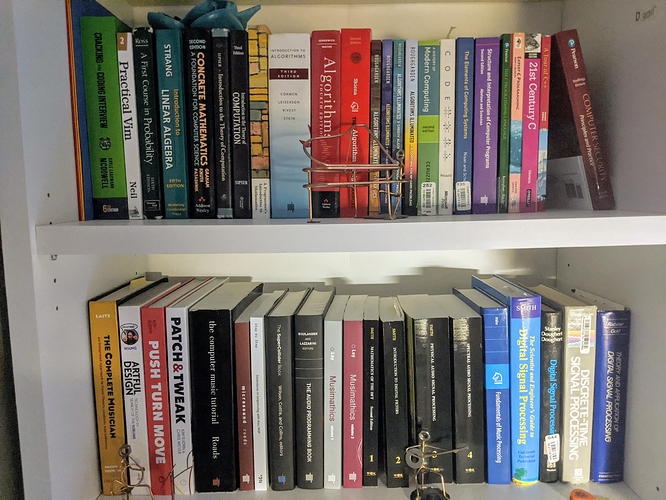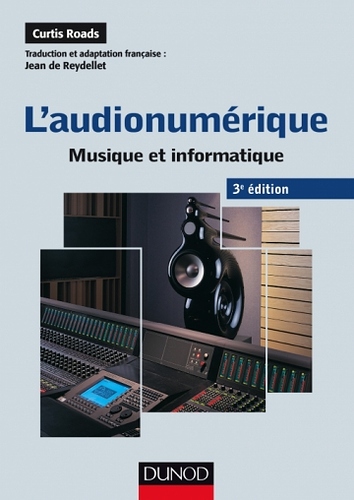Re-reading Rick Taube’s superb book on algorithmic composition.
Rearranged my bookshelf! Here’s most of the computer + music stuff (not showing the shelves of sheet music and theory books and other things I like to read)…
Currently reading some not-pictured Andy Weir short stories for my weekly book club. We’ve been doing short stories since the beginning of March, and the consistency of it has been reassuring in these crazy months!
Six months ago I stopped having to do the work commute where I would read every day for an hour on the bus and since then I’ve not read a single ‘proper’ book, though I’ve regressed into childhood by signing up to Marvel Unlimited for a year and I’ve read hundreds of comics. The last book I was reading and haven’t yet finished was The Three-Body Problem which was pretty average though I probably missed a load of deeper references you’d have to be Chinese to pick up on.
Interviews to Coil. They could make you puke, question your own worldviews, lead you to enlightenment or simply amuse you with their easy-going misuse of all sorts of equipment.
Coil’s music has some decidedly down-to-earth aspects – namely, the hardware Christopherson uses. “Apart from the guitars and brass instruments and some live strings mixed with Fairlight III strings, everything else on Horse Rotorvator is artificial,” he notes. “Quite a lot of those sounds were created using an [Emu Systems] Emulator II function to destroy the original sample and produce something else. I used the VCAs and VCFs to do real-time modulation of the original sample.” The Emulator II also played a starring role in the songwriting. “The initial sequences consisted of multi-tracked sample combinations done on the Emulator,” he explains. “In most cases, what I did was download those sequences into a Fairlight by means of the MIDI output. You can edit much more easily on a Fairlight than on an Emulator.” To avoid the android stiffness of sequence-based songwriting, Christopherson and company “try and con the machines into doing what we want, even though sometimes the machines weren’t even designed to do that.” For Horse Rotorvator, the conned machines include a Fairlight II and III for sequencing and editing, Emulator II as the main sound generator, Yamaha DX7, PPG Wave 2.2, and an EMS Synthi for the heavy, distorted sounds. “The Synthi,” Christopherson says, “was like a portable version of their VCS-3 from '72. it has a collection of VCAs and ring modulators. The way you connect the oscillators and filters is via a matrix board, where you put pins in to make the connections.” Additional artillery included "a few old Woolworth’s-type flangers and distortion pedals. But don’t be fooled by all the bits and bytes. Coil are not master musicians. “I can’t really play properly,” Christopherson asserts blithely. “None of us can really play in the conventional sense.”
My PSU popped on Sunday, so while waiting for a replacement I’ve read most of A Song for Arbonne buy Guy Gavriel Kay and a couple of Montalbano Novels. Also recently finished Bleeding Edge by Thomas Pynchon.
I’m currently reading a book by Vlad Kreimer - maker of synths Lyra8 and Pulsar23. Although the book is not about music or synthesis, it contains interesting philosophy ideas. And this book is free!
i remember seeing that speaker in an issue of Wired 25 years ago. I always wondered whether it was any good
Ah yes the Nautilus, I vaguely remember it cost as much as a house at the time. A sad indicator to me of how much house prices have risen since and how I have even less chance of owning either now.
Just finished Dogs of War by Adrian Tchaikovsky, which was ace. (Sequel out next year. Yay!)
Next on the starting block…
- 2000 TC: Standing on the Verge of Getting It On by John Higgs
- High Weirdness by Erik Davies
- Wiffle Lever to Full! by Bob Fischer
Edit: This is me on Goodreads, if anyone’s at all interested. ![]()
Nice. Have you read Children of Ruin yet? It’s pretty good. Sci-fi and fantasy are my literary comfort foods and recently got into Neal Stephenson and Dan Simmons and for outright silliness Jasper Fforde and David Wong.
Yes, I’ve read Children of Ruin Time. Wasn’t expecting that ending! Not read the second one yet but it’s in the tsundoku pile.  I like Dan Simmons very much. I reread his Ilium and Olympus every five years of so. Lots of fun. Not got around to Neil Stephenson, yet. Also like Peter F. Hamilton a lot as well. Sorry, waffling.
I like Dan Simmons very much. I reread his Ilium and Olympus every five years of so. Lots of fun. Not got around to Neil Stephenson, yet. Also like Peter F. Hamilton a lot as well. Sorry, waffling. 
Dogs of war slightly puts me in mind of the rat things from Neal Stephenson’s Snow Crash.
Waffle away. Children of Ruin is the sequel to Children of Time btw.
One of the lighter books I read recently that I enjoyed was Grunts! by Mary Gentle which is set at the time of Lord Of The Rings where some orcs are hit with a spell that makes them act like US Marines in the Vietnam war.
Whoops! I meant Children of Time. Brain not working.
Grunts! looks interesting. I’m not one for fantasy so much but that looks like a good take. Edit: Grabbed the eBook after reading a sample. Looks great!
Is that one a good place to start with his books? I’ve never read any by him.
Yes, it’s a very good place to start. The Baroque Cycle (four linked books starting with Quicksilver) is his masterpiece IMO and not really SF, more historical fiction, but it’s a rollicking read.
Snow Crash is quite funny and an interesting satire but I don’t feel it’s dated particularly well. Cryptonomicon is better in my opinion and, because it’s set in the then current year (1999), has dated a lot less. The general critique of Stephenson is that he can’t write women and his endings are bad. I think the first is true but the second is just some peoples need for a happy ending.
My favorite Neal Stephenson books are:
#1: The Diamond Age
#2: Cryptonomicon
#3: Anathem
also Interface (written under the pseudonym Stephen Bury) is pretty good, and unfortunately topical for our times.
I only read the Diamond Age recently and wasn’t prepared for how psychedelicly crazy it was. Bordering on Ribofunk or Vurt.


